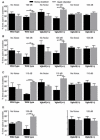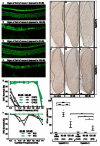A non-canonical pathway from cochlea to brain signals tissue-damaging noise
- PMID: 25639244
- PMCID: PMC4348215
- DOI: 10.1016/j.cub.2015.01.009
A non-canonical pathway from cochlea to brain signals tissue-damaging noise
Abstract
Intense noise damages the cochlear organ of Corti, particularly the outer hair cells (OHCs) [1]; however, this epithelium is not innervated by nociceptors of somatosensory ganglia, which detect damage elsewhere in the body. The only sensory neurons innervating the organ of Corti originate from the spiral ganglion, roughly 95% of which innervate exclusively inner hair cells (IHCs) [2-4]. Upon sound stimulation, IHCs release glutamate to activate AMPA-type receptors on these myelinated type-I neurons, which carry the neuronal signals to the cochlear nucleus. The remaining spiral ganglion cells (type IIs) are unmyelinated and contact OHCs [2-4]. Their function is unknown. Using immunoreactivity to cFos, we documented neuronal activation in the brainstem of Vglut3(-/-) mice, in which the canonical auditory pathway (activation of type-I afferents by glutamate released from inner hair cells) is silenced [5, 6]. In these deaf mice, we found responses to noxious noise, which damages hair cells, but not to innocuous noise, in neurons of the cochlear nucleus, but not in the vestibular or trigeminal nuclei. This response originates in the cochlea and not in other areas also stimulated by intense noise (middle ear and vestibule) as it was absent in CD1 mice with selective cochlear degeneration but normal vestibular and somatosensory function. These data imply the existence of an alternative neuronal pathway from cochlea to brainstem that is activated by tissue-damaging noise and does not require glutamate release from IHCs. This detection of noise-induced tissue damage, possibly by type-II cochlear afferents, represents a novel form of sensation that we term auditory nociception.
Copyright © 2015 Elsevier Ltd. All rights reserved.
Figures




Comment in
-
Sensory systems: noisy nociception.Nat Rev Neurosci. 2015 Mar;16(3):122. doi: 10.1038/nrn3926. Nat Rev Neurosci. 2015. PMID: 25697156 No abstract available.
References
-
- Liberman MC, Kiang NY. Acoustic trauma in cats. Cochlear pathology and auditory-nerve activity. Acta Otolaryngol Suppl. 1978;358:1–63. - PubMed
-
- Dannhof BJ, Bruns V. The innervation of the organ of Corti in the rat. Hearing research. 1993;66:8–22. - PubMed
-
- Spoendlin H. Innervation densities of the cochlea. Acta Otolaryngol. 1972;73:235–248. - PubMed
-
- Kiang NY, Rho JM, Northrop CC, Liberman MC, Ryugo DK. Hair-cell innervation by spiral ganglion cells in adult cats. Science. 1982;217:175–177. - PubMed
-
- Ruel J, Emery S, Nouvian R, Bersot T, Amilhon B, Van Rybroek JM, Rebillard G, Lenoir M, Eybalin M, Delprat B, et al. Impairment of SLC17A8 encoding vesicular glutamate transporter-3, VGLUT3, underlies nonsyndromic deafness DFNA25 and inner hair cell dysfunction in null mice. Am J Hum Genet. 2008;83:278–292. - PMC - PubMed
Publication types
MeSH terms
Substances
Grants and funding
LinkOut - more resources
Full Text Sources
Other Literature Sources
Medical
Molecular Biology Databases

